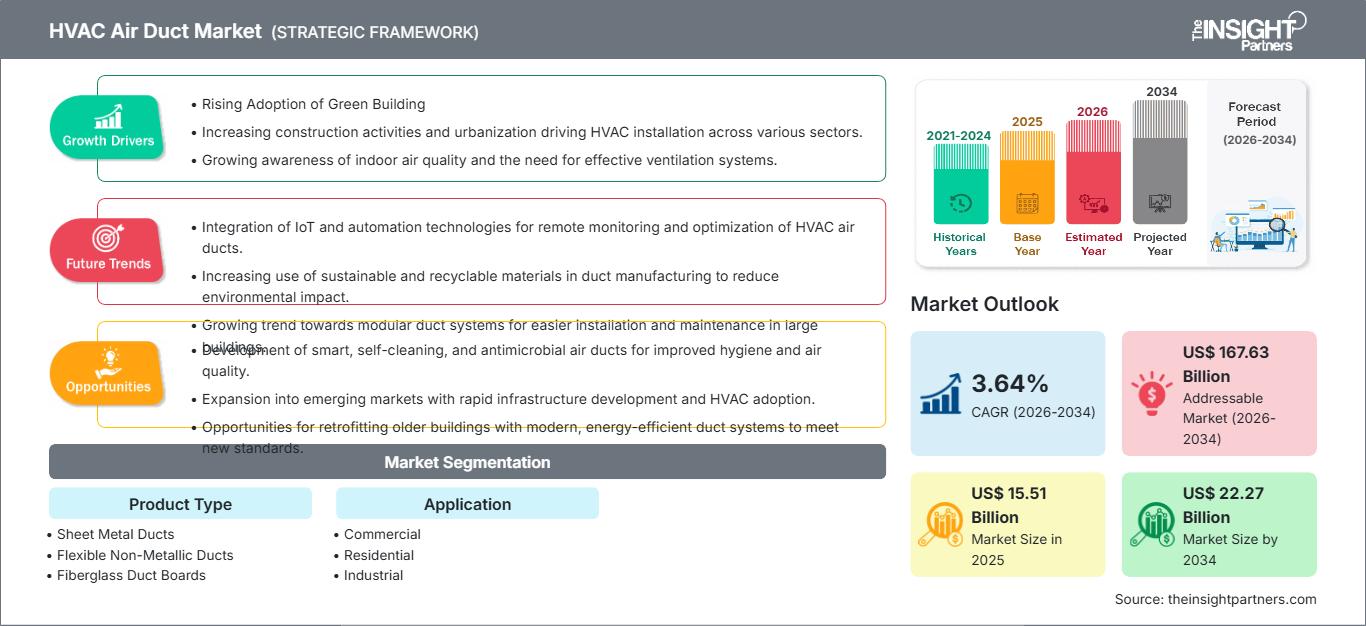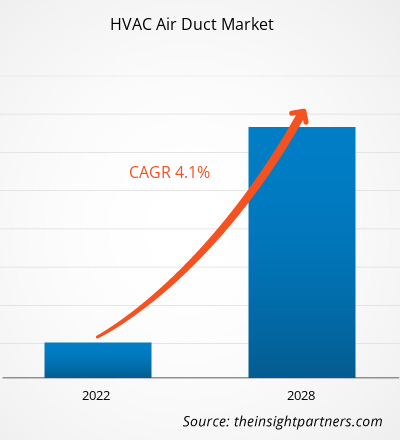Der Markt für Lüftungskanäle im Bereich der Klimatechnik wird bis 2034 voraussichtlich ein Volumen von 22,27 Milliarden US-Dollar erreichen, gegenüber 15,51 Milliarden US-Dollar im Jahr 2025. Es wird erwartet, dass der Markt im Zeitraum 2026–2034 eine durchschnittliche jährliche Wachstumsrate (CAGR) von 3,64 % verzeichnen wird.
Marktanalyse für HLK-Luftkanäle
Die Prognose für den Markt für Lüftungskanäle in der Klimatechnik deutet auf ein stetiges Wachstum hin, angetrieben durch die Urbanisierung, Energieeffizienzvorschriften und die steigende Nachfrage nach verbesserter Raumluftqualität. Die Marktexpansion wird durch den zunehmenden Fokus auf Sanierungsprojekte und die weltweite Einführung intelligenter Kanalsysteme begünstigt.
Marktübersicht für HLK-Luftkanäle
Luftkanäle sind grundlegende Bestandteile von Heizungs-, Lüftungs- und Klimaanlagen, da sie einen effizienten Luftstrom und eine präzise Temperaturregelung ermöglichen. Das System vereinfacht die Steuerung von Luftverteilung, Feuchtigkeitsregulierung und thermischem Komfort. Durch die Steigerung der Effizienz, die Reduzierung von Energieverlusten und die Schaffung eines gesünderen Raumklimas ermöglichen Luftkanalsysteme Gebäudeeigentümern und Facility Managern die Einhaltung von Vorschriften und die Gewährleistung komfortabler Bedingungen. Zunehmende Bautätigkeit und Nachhaltigkeitsauflagen treiben das Marktwachstum an.
Passen Sie diesen Bericht Ihren Anforderungen an.
Sie erhalten eine kostenlose Anpassung aller Berichte – einschließlich Teilen dieses Berichts, Länderanalysen und Excel-Datenpaketen – sowie attraktive Angebote und Rabatte für Start-ups und Universitäten.
Markt für HLK-Luftkanäle: Strategische Einblicke

-
Ermitteln Sie die wichtigsten Markttrends dieses Berichts.Diese KOSTENLOSE Probe beinhaltet eine Datenanalyse, die von Markttrends bis hin zu Schätzungen und Prognosen reicht.
Markttreiber und Chancen im Bereich HLK-Luftkanäle
Markttreiber:
- Urbanisierung und Infrastrukturwachstum: Die rasante städtische Entwicklung und groß angelegte Infrastrukturprojekte treiben die Installation neuer Lüftungskanäle im gewerblichen und privaten Bereich voran.
- Energieeffizienzstandards: Strengere staatliche Vorschriften fördern die Einführung von isolierten, vorabgedichteten und leckagearmen Kanalsystemen, um den Energieverbrauch zu senken.
- Bewusstsein für die Innenraumluftqualität: Der nach der Pandemie gestiegene Fokus auf die Belüftungsqualität treibt die Nachfrage nach besseren Kanalmaterialien, antimikrobiellen Beschichtungen und fortschrittlichen Systemen voran, die mit Hochleistungsfiltration kompatibel sind.
Marktchancen:
- Intelligente Lüftungssysteme: Die Integration von IoT, Sensoren und KI zur Echtzeitüberwachung sowie zur automatischen Ausgleichs- und Energieoptimierung kann eine wertvolle Chance darstellen.
- Schwellenländer: Die Expansion im asiatisch-pazifischen Raum und in Lateinamerika, mit rascher Industrialisierung, steigendem verfügbaren Einkommen und wachsender Gesundheitsinfrastruktur, treibt die Nachfrage an.
- Nachrüstungs- und Sanierungsprojekte: Modernisierung bestehender, ineffizienter Lüftungsanlagen in älteren Gewerbe- und Wohngebäuden, um moderne Energie- und Luftqualitätsstandards zu erfüllen.
Marktbericht für HLK-Luftkanäle: Segmentierungsanalyse
Der Marktanteil von HLK-Luftkanälen wird in verschiedenen Segmenten analysiert, um ein besseres Verständnis seiner Struktur, seines Wachstumspotenzials und der aufkommenden Trends zu ermöglichen. Nachfolgend ist der in den meisten Branchenberichten verwendete Standard-Segmentierungsansatz dargestellt:
Nach Produkttyp:
- Blechkanäle: Die gebräuchlichsten Materialien (verzinkter Stahl, Aluminium) sind bekannt für ihre Langlebigkeit, ihre porenfreie Oberfläche und ihre Dominanz in kommerziellen und industriellen Anwendungen.
- Flexible, nichtmetallische Kanäle: Werden für kurze Strecken und zum Verbinden von Hauptkanälen mit Diffusoren verwendet und sind aufgrund der einfachen Installation und Flexibilität bei der Sanierung von Wohnhäusern bevorzugt.
- Glasfaser-Kanalplatten: Glasfaser-Kanalplatten bieten eine ausgezeichnete Wärmedämmung und Schallabsorption und eignen sich daher besonders für geräuschempfindliche Orte wie Büros und Krankenhäuser.
Auf Antrag:
- Gewerblich: Dazu gehören Bürogebäude, Einzelhandelsflächen, Krankenhäuser, Schulen und Flughäfen, die großflächige und komplexe Lüftungssysteme erfordern.
- Wohngebäude: Bürogebäude, Einzelhandelsflächen, Krankenhäuser, Schulen und Flughäfen – all diese Gebäude benötigen großflächige und komplexe Lüftungssysteme.
- Industrie: Umfasst Produktionsanlagen, Lagerhallen und Reinräume, die häufig spezielle, langlebige und manchmal feuerbeständige Lüftungskanäle erfordern.
Nach Geographie:
- Nordamerika
- Europa
- Asien-Pazifik
- Süd- und Mittelamerika
- Naher Osten und Afrika
Regionale Einblicke in den Markt für HLK-Luftkanäle
Die regionalen Trends und Einflussfaktoren auf den Markt für HLK-Luftkanäle im gesamten Prognosezeitraum wurden von den Analysten von The Insight Partners ausführlich erläutert. Dieser Abschnitt behandelt außerdem die Marktsegmente und die geografische Verteilung des HLK-Luftkanalmarktes in Nordamerika, Europa, Asien-Pazifik, dem Nahen Osten und Afrika sowie Süd- und Mittelamerika.
Umfang des Marktberichts zu HLK-Luftkanälen
| Berichtattribute | Details |
|---|---|
| Marktgröße im Jahr 2025 | 15,51 Milliarden US-Dollar |
| Marktgröße bis 2034 | 22,27 Milliarden US-Dollar |
| Globale durchschnittliche jährliche Wachstumsrate (2026 - 2034) | 3,64 % |
| Historische Daten | 2021-2024 |
| Prognosezeitraum | 2026–2034 |
| Abgedeckte Segmente |
Nach Produkttyp
|
| Abgedeckte Regionen und Länder |
Nordamerika
|
| Marktführer und wichtige Unternehmensprofile |
|
Marktdichte der Akteure im Bereich HLK-Luftkanäle: Auswirkungen auf die Geschäftsdynamik verstehen
Der Markt für Lüftungskanäle in der Klimatechnik wächst rasant, angetrieben durch die steigende Nachfrage der Endverbraucher. Gründe hierfür sind unter anderem sich wandelnde Verbraucherpräferenzen, technologische Fortschritte und ein wachsendes Bewusstsein für die Vorteile des Produkts. Mit steigender Nachfrage erweitern Unternehmen ihr Angebot, entwickeln innovative Lösungen, um den Kundenbedürfnissen gerecht zu werden, und nutzen neue Trends, was das Marktwachstum zusätzlich beflügelt.

- Verschaffen Sie sich einen Überblick über die wichtigsten Akteure im Markt für HLK-Luftkanäle.
Marktanteilsanalyse für HLK-Luftkanäle nach Regionen
Der asiatisch-pazifische Raum führt mit dem größten Marktanteil, gefolgt von Nordamerika und Europa. Für die Region Asien-Pazifik wird im Prognosezeitraum das schnellste Wachstum erwartet. Der Markt für Lüftungskanäle im Bereich der Klimatechnik weist in den einzelnen Regionen aufgrund von Faktoren wie Bauvorschriften, Klimamustern und Energieeffizienzvorgaben unterschiedliche Wachstumsverläufe auf. Nachfolgend finden Sie eine Zusammenfassung der Marktanteile und Trends nach Regionen:
Asien-Pazifik
- Marktanteil: Dominiert den Weltmarkt, angetrieben durch die rasante Urbanisierung, massive Infrastrukturausgaben und die Industrialisierung in Ländern wie China und Indien.
-
Wichtigste Einflussfaktoren:
- staatlich unterstützte Standards für umweltfreundliches Bauen
- Hohe Nachfrage nach energieeffizienten Kühllösungen aufgrund des Klimas
- Ausbau der Industrie- und Handelsbasis
- Trends: Hohe Akzeptanzraten sowohl im Neubau von Gewerbeimmobilien als auch bei der Erweiterung von Wohnbauprojekten, mit zunehmendem Einsatz von isolierten und flexiblen Kanalsystemen.
Nordamerika
- Marktanteil: Hält aufgrund ausgereifter Bausektoren und strenger Energieauflagen einen bedeutenden Marktanteil.
-
Wichtigste Einflussfaktoren:
- Strenge Energievorschriften (z. B. ENERGY STAR, ASHRAE)
- Eine große Anzahl älterer Gebäude muss saniert werden.
- Schwerpunkt auf der Verbesserung der Innenraumluftqualität.
- Trends: Starke Nachfrage nach hochleistungsfähigen, isolierten Kanalsystemen und ein steigendes Volumen von Nachrüstungsprojekten für HLK-Systeme in älteren Gewerbe- und Wohngebäuden zur Verbesserung der Effizienz und der Luftqualität.
Europa
- Marktanteil: Hält einen bedeutenden Marktanteil, der durch Initiativen für nachhaltiges Bauen und EU-Vorgaben zur Energieeffizienz begünstigt wird.
-
Wichtigste Einflussfaktoren:
- EU-Vorgaben für Energieeffizienz- und Luftdichtheitsstandards.
- Setzen Sie sich für Gebäude mit geringem CO2-Fußabdruck ein.
- Hohe Akzeptanz nachhaltiger und langlebiger Materialien
- Trends: Zunehmender Einsatz von fortschrittlichen Materialien und vorisolierten Kanälen zur Einhaltung strenger Umwelt- und Energieeffizienzrichtlinien sowie zur Unterstützung grenzüberschreitender Standards.
Süd- und Mittelamerika
- Marktanteil: Aufstrebender Markt mit hohem Wachstumspotenzial, angetrieben durch öffentliche und private Bauinvestitionen.
-
Wichtigste Einflussfaktoren:
- Öffentliche und private Bauinvestitionen
- Stadterweiterung und Gewerbeentwicklung
- Zunehmende Verbreitung moderner HLK-Systeme
- Trends: Die Nachfrage konzentriert sich auf skalierbare, kosteneffiziente Lösungen für neue Infrastruktur- und Wohnbauprojekte, wobei die Langlebigkeit in unterschiedlichen Klimazonen Priorität hat.
Naher Osten und Afrika
- Marktanteil: Entwicklungsmarkt mit starkem Wachstumspotenzial aufgrund des zunehmenden Ausbaus der Gesundheits- und Gewerbeinfrastruktur.
-
Wichtigste Einflussfaktoren:
- Massive Investitionen in die kommerzielle und medizinische Infrastruktur
- Hohe Nachfrage nach robusten Kühllösungen
- Nationale Strategien für E-Health und den Ausbau der Infrastruktur
- Trends: Der Einsatz hocheffizienter, korrosionsbeständiger Lüftungskanäle ist für groß angelegte, missionskritische Anwendungen und Anlagen in heißen Klimazonen notwendig.
Marktdichte der Akteure im Bereich HLK-Luftkanäle: Auswirkungen auf die Geschäftsdynamik verstehen
Hohe Marktdichte und starker Wettbewerb
Der Wettbewerb auf dem Markt für Lüftungskanäle im Bereich der Klimatechnik verschärft sich aufgrund der Präsenz sowohl großer multinationaler Hersteller von Klimasystemen (wie Daikin, Carrier und Trane Technologies) als auch spezialisierter Kanalhersteller und Komponentenanbieter. Diese fragmentierte Landschaft zwingt die Anbieter, sich durch Produktinnovationen und spezialisierte Serviceleistungen zu differenzieren.
Dieses wettbewerbsintensive Umfeld zwingt die Anbieter dazu, sich durch Folgendes zu differenzieren:
- Entwicklung hocheffizienter, luftdichter und isolierter Kanalsysteme, oft unter Verwendung vorisolierter Paneele und fortschrittlicher Abdichtungstechniken.
- Die Entwicklung flexibler und leichter Produkte für eine einfachere Montage und geringere Arbeitskosten unterstützt den Trend zum modularen Bauen.
- Strategische Partnerschaften zur Integration von Lüftungskanälen mit intelligenten HLK-Steuerungen und Gebäudeleitsystemen (GLT) für eine verbesserte Überwachung und Optimierung.
- Schwerpunkt ist die Entwicklung korrosionsbeständiger und feuerfester Werkstoffe für spezielle industrielle und unternehmenskritische Anwendungen.
Chancen und strategische Schritte
- Investieren Sie in digitale Werkzeuge wie Building Information Modeling (BIM) und Computational Fluid Dynamics (CFD), um maßgeschneiderte und optimierte Kanalkonstruktionen zu unterstützen.
- Integrieren Sie Merkmale, die die Innenraumluftqualität (IAQ) verbessern, wie z. B. antimikrobielle Beschichtungen und Systeme, die für eine einfache Reinigung/Wartung konzipiert sind.
Die wichtigsten Unternehmen auf dem Markt für HLK-Luftkanäle sind:
- Tin Man Sheet Metal Fabrication, LLC
- Hennemuth Metallverarbeiter
- Waves Aircon Pvt. Ltd.
- DuctSox
- Lindab
- Schlüsselfertige Lüftungssysteme
- M&M Manufacturing
- SetDuct
- US-Kanal
- Daikin Industries Ltd. (Globaler Akteur im Bereich HLK)
Hinweis: Die oben aufgeführten Unternehmen sind nicht in einer bestimmten Reihenfolge geordnet.
Neuigkeiten und aktuelle Entwicklungen auf dem Markt für HLK-Luftkanäle
- Lindab führt fossilfreie Stahlkanäle für nachhaltige Lüftungsprojekte ein: Lindab gab die Auslieferung von Lüftungskanälen aus fossilfreiem Stahl für Pilotprojekte in Schweden bekannt – eine weltweit erstmalige Produktion nachhaltiger Lüftungskanäle. Das Unternehmen unterzeichnete zudem einen Siebenjahresvertrag mit H2 Green Steel zur Beschaffung emissionsfreien Stahls ab 2026 und erweiterte sein Produktsortiment um Kanäle aus 75 % Recyclingstahl, wodurch die Klimabelastung um 62 % reduziert wird.
- US Duct erweitert seine Geschäftstätigkeit mit einem neuen Vertriebszentrum in North Carolina: US Duct erwarb ein 23.400 Quadratmeter großes Lager in High Point, North Carolina, für 8,15 Millionen US-Dollar. Die Anlage wird die Effizienz der Lieferkette verbessern und Transportemissionen reduzieren. Das Gebäude wurde mit dem CoStar Impact Award 2025 für seine positiven regionalen Auswirkungen und die Schaffung von Arbeitsplätzen ausgezeichnet.
- M&M Manufacturing bringt luftdichte DucTite®-Fittings auf den Markt: M&M Manufacturing hat DucTite® eingeführt, eine Produktlinie werkseitig abgedichteter Fittings, die die Abdichtung vor Ort überflüssig macht, den Installateuren Zeit spart und die Arbeitskosten senkt, während gleichzeitig die Luftdichtheit des Systems verbessert wird.
Marktbericht über Lüftungskanäle (HLK): Abdeckung und Ergebnisse
Der Bericht „Marktgröße und Prognose für HLK-Luftkanäle (2021–2034)“ bietet eine detaillierte Analyse des Marktes, die folgende Bereiche abdeckt:
- Marktgröße und Prognose für den Markt für HLK-Luftkanäle auf globaler, regionaler und Länderebene für alle wichtigen Marktsegmente, die im Geltungsbereich abgedeckt werden
- Trends im Markt für HLK-Luftkanäle sowie Marktdynamiken wie Treiber, Hemmnisse und wichtige Chancen
- Detaillierte PEST- und SWOT-Analyse
- Marktanalyse für HLK-Luftkanäle: Wichtige Markttrends, globale und regionale Rahmenbedingungen, Hauptakteure, regulatorische Rahmenbedingungen und aktuelle Marktentwicklungen
- Branchenlandschafts- und Wettbewerbsanalyse mit Fokus auf Marktkonzentration, Heatmap-Analyse, führende Akteure und aktuelle Entwicklungen im Markt für HLK-Luftkanäle
- Detaillierte Unternehmensprofile
- Historische Analyse (2 Jahre), Basisjahr, Prognose (7 Jahre) mit CAGR
- PEST- und SWOT-Analyse
- Marktgröße Wert/Volumen – Global, Regional, Land
- Branchen- und Wettbewerbslandschaft
- Excel-Datensatz
Aktuelle Berichte
Erfahrungsberichte
Grund zum Kauf
- Fundierte Entscheidungsfindung
- Marktdynamik verstehen
- Wettbewerbsanalyse
- Kundeneinblicke
- Marktprognosen
- Risikominimierung
- Strategische Planung
- Investitionsbegründung
- Identifizierung neuer Märkte
- Verbesserung von Marketingstrategien
- Steigerung der Betriebseffizienz
- Anpassung an regulatorische Trends






















 Kostenlose Probe anfordern für - Markt für Lüftungsanlagen
Kostenlose Probe anfordern für - Markt für Lüftungsanlagen